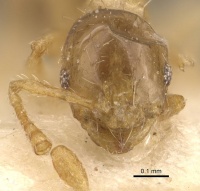Monomorium gabrielense
| Monomorium gabrielense | |
|---|---|

| |
| Scientific classification | |
| Kingdom: | Animalia |
| Phylum: | Arthropoda |
| Class: | Insecta |
| Order: | Hymenoptera |
| Family: | Formicidae |
| Subfamily: | Myrmicinae |
| Tribe: | Solenopsidini |
| Genus: | Monomorium |
| Species: | M. gabrielense |
| Binomial name | |
| Monomorium gabrielense Forel, 1916 | |
Known from forest habitat collections of leaf litter and soil samples.
Identification
Bolton (1987) - A member of the M. strangulatum complex in the M. monomorium species group. The minute pale gabrielense is close to Monomorium noxitum, Monomorium draxocum and Monomorium strangulatum. The last named is immediately separable as it has only 11 antennal segments, as opposed to 12 in the remainder. Both noxitum and draxocum are brown to black in colour, much darker than gabrielense, and both are larger, though only slightly so in draxocum. Comparative dimensions are as follows.
- gabrielense HW 0.30-0.32; SL 0.30-0.31; PW 0.19-0.20
- draxocum HW 0.32-0.35; SL 0.32-0.36; PW 0.22-0.23
- noxitum HW 0.37-0.40; SL 0.39-0.42; PW 0.24-0.27
Keys including this Species
Distribution
Distribution based on Regional Taxon Lists
Afrotropical Region: Democratic Republic of Congo (type locality), Gabon.
Distribution based on AntMaps
Distribution based on AntWeb specimens
Check data from AntWeb
Countries Occupied
| Number of countries occupied by this species based on AntWiki Regional Taxon Lists. In general, fewer countries occupied indicates a narrower range, while more countries indicates a more widespread species. |

|
Estimated Abundance
| Relative abundance based on number of AntMaps records per species (this species within the purple bar). Fewer records (to the left) indicates a less abundant/encountered species while more records (to the right) indicates more abundant/encountered species. |

|
Biology
Castes
Nomenclature
The following information is derived from Barry Bolton's Online Catalogue of the Ants of the World.
- gabrielense. Monomorium rhopalocerum var. gabrielensis Forel, 1916: 418 (w.q.) DEMOCRATIC REPUBLIC OF CONGO.
- Type-material: syntype workers, syntype queen(s) (numbers not stated).
- Type-locality: Democratic Republic of Congo (“Congo”): St Gabriel (H. Kohl).
- Type-depository: MHNG
- Subspecies of rhopalocerum: Wheeler, W.M. 1922a: 867; Emery, 1922e: 173; Ettershank, 1966: 89.
- Status as species: Bolton, 1987: 392 (redescription); Bolton, 1995b: 262.
- Distribution: Democratic Republic of Congo, Gabon.
Unless otherwise noted the text for the remainder of this section is reported from the publication that includes the original description.
Description
Worker
Bolton (1987) - TL 1.5-1.6, HL 0.38-0.40, HW 0.30-0.32, CI 78-84, SL 0.30-0.31, SI 95-100, PW 0.19-0.20, AL 0.42-0.44 (10 measured).
Clypeal carinae close posteriorly, moderately divergent anteriorly and reaching the anterior margin. Prominent median portion of clypeus narrow, the anterior margin between the apices of the carinae shallowly concave. Anterior and lateral margins of median portion of clypeus separated by an angle, without projecting denticles. Eyes relatively small, their maximum diameter 0.19-0.22 x HW and with 5 ommatidia in the longest row. With the head in full-face view the eyes close to the midlength of the sides; usually the posterior margins of the eyes on the midline. Antennal scapes, when laid straight back from their insertions, slightly exceeding the occipital margin. In full-face view the sides behind the eyes and the occipital margin usually forming a single even convexity, but in a few workers a minute mid-occipital depression may be present. In profile the dorsal and ventral surfaces of the head distinctly biconvex. Promesonotum in profile smoothly and evenly convex, sloping posteriorly to the shallowly impressed metanotal groove, highest point of promesonotal curve on a conspicuously higher level than the propodeum. Cross-ribs of metanotal groove short and inconspicuous, the propodeal spiracle large and easily visible. Propodeal dorsum highest just behind metanotal groove, sloping posteriorly to the obtuse rounded angle which separates dorsum from declivity; the two surfaces not forming a smooth even curve. Petiole node in profile subconical and narrowly rounded above , the subpetiolar process a narrow and inconspicuous laminar strip. Postpetiole node smaller, lower and more broadly convex than petiole node in profile. All dorsal surfaces of head and body with standing hairs present, the promesonotum with 4-5 pairs, and many hairs on head and first gastral tergite blunt or truncated apically. Sculpture consisting only of scattered hair-pits, metanotal cross-ribs, and a band of fine reticulation traversing the mesopleuron; otherwise entirely smooth and shining. Colour yellow, the gaster with a brownish tint.
Type Material
Bolton (1987) - Syntype workers, female, Zaire: St Gabriel (Kohl) (Musee d'Histoire Naturelle Genève) [examined].
References
- Bolton, B. 1987. A review of the Solenopsis genus-group and revision of Afrotropical Monomorium Mayr (Hymenoptera: Formicidae). Bulletin of the British Museum (Natural History). Entomology. 54: 263-452.. (page 392, Raised to species)
- Forel, A. 1916. Fourmis du Congo et d'autres provenances récoltées par MM. Hermann Kohl, Luja, Mayné, etc. Reue. Suisse de Zoologie. 24:397-460.
References based on Global Ant Biodiversity Informatics
- Belshaw R., and B. Bolton. 1994. A survey of the leaf litter ant fauna in Ghana, West Africa (Hymenoptera: Formicidae). Journal of Hymenoptera Research 3: 5-16.
- Belshaw R., and B. Bolton. 1994. A survey of the leaf litter ant fauna in Ghana, West Africa (Hymenoptera: Formicidae). Journal of Hymenoptera Research. 3: 5-16.
- Wheeler W. M. 1922. Ants of the American Museum Congo expedition. A contribution to the myrmecology of Africa. VIII. A synonymic list of the ants of the Ethiopian region. Bulletin of the American Museum of Natural History 45: 711-1004

